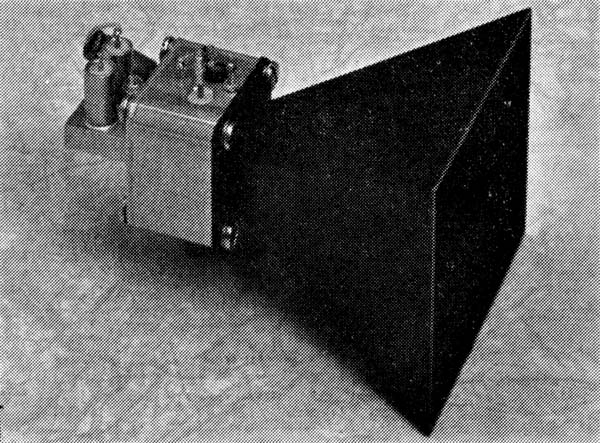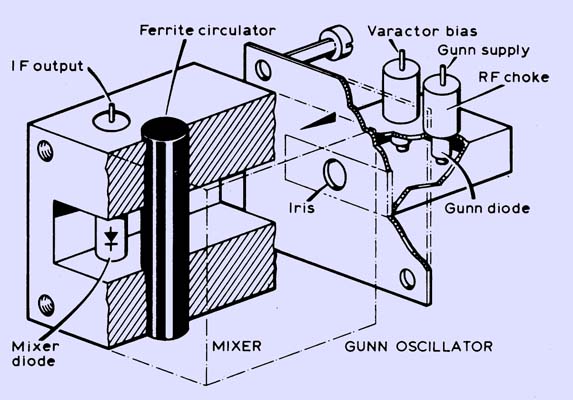|

The Microwave Associates Front End
It is perhaps something of a compliment to amateurs that Microwave Associates in the USA have felt it worthwhile to produce a Gunn transceiver front-end specifically for the 10 GHz amateur band. Details are given in their Bulletin 7624. In the complete unit shown in the photograph, the rear part consists of a Gunn oscillator generating 20 mW which is tuned, unless otherwise specified, to 10,250 MHz. Each unit may be tuned mechanically by plus or minus 100 MHz to shift the centre frequency, and also by up to 60 MHz by varying the bias on a tuning varactor over the range l-20V. This latter facility may in addition be used to apply frequency modulation, for fine tuning and for introducing automatic frequency control.
The front portion consists of a waveguide-mounted Schottky diode mixer and includes, most significantly, a circulator. The latter means that the full output of the oscillator and the potentially low noise figure of the mixer - expected to be better than 12dB - can be obtained at the same time from a 'single-ended' device, with all the advantages that the latter feature implies. As illustrated, the unit is fitted with a horn antenna of 17dB gain, which is rather low compared with the 25-35dB gain of the antennas mostly used by UK amateurs. Nevertheless, even with these antennas, the range over line-of-sight paths according to my back-of-an-envelope calculations should be at least 70km if an IF bandwidth of 200kHz is used. In a perfect duct, the range will be thousands of kilometres. Prices for these devices in the USA are: $60 for the Gunn oscillator alone, $85 for the transceiver without the horn, $108 with the horn or $180 for a pair.
Review by Barry Chambers (G8AGN)
Until recently most amateurs wishing to operate in the 10 GHz band have only had the choice of either constructing their own waveguide front-end from scratch or modifying ex-radar components to bring them into the band. This situation has now been changed somewhat with the introduction by Microwave Associates of their series of Gunnplexer 10 GHz transceiver front-ends designed specifically for the amateur market.

Diagrammatic view of the Gunnplexer
As shown above, the rear portion of the transceiver unit consists of a single Gunn diode, operating in an iris-coupled cavity, which provides both the transmitter RF output and the local oscillator injection for the mixer diode. The oscillator cavity may be tuned both mechanically by means of a ceramic slug, and electrically using a varactor diode which is mounted by the side of the Gunn diode. This facility for electrical tuning makes the application of frequency modulation, fine tuning and AFC very straightforward.
In front of the Gunn cavity, and coupled to it by means of an iris, is a short section of waveguide containing a Schottky diode mixer and a piece of ferrite rod which acts as a circulator to separate the transmitter and receiver functions. The latter facility means that the front-end can be used simultaneously as a transmitter and a receiver, and hence full duplex operation is possible.
Normally the front-ends are supplied complete with a small horn antenna having a nominal gain of 17 dB, butthe individual components can also be obtained separately. The range of options available is:
Application - RF output frequency (MHz)
MA-87108-1 - 10.25GHz 15mW voltage tuned Gunn oscillator
MA-87127-1 - Complete 10GHz 15mW transceiver
MA-87140-1 - Complete 10GHz 15mW transceiver and antenna
MA-87127-2 - Complete 10GHz 25mW transceiver
MA-87140-2 - Complete 10GHz 25mW transceiver and antenna
MA-87127-3 - Complete 10GHz 40mWtransceiver
MA-87140-3 - Complete 10GHz 4OmW transceiver and antenna
The performance of the front-end as a receiver was not measured, since the receiver sensitivity and noise figureachieved in practice will be largely dependent on the individual's choice of IF strip and the degree of matchingbetween the mixer diode and the IF pre-amplifier. In the main, therefore, measurements were made only to check the performance of the Gunn oscillator. In the unit which was tested, the frequency of the oscillator had been presetto 10,380 MHz, and this frequency was recorded on a label stuck to the back plate of the cavity.
On connecting a variable voltage stabilized power supply to the Gunn diode it was found that RF power was produced with an applied voltage as low as 5V, but most of the tests were carried out with 10V applied to the Gunn diode and 4V bias on the varactor diode.
Using a Systron-Donner model 6057 frequency counter having an upper frequency limit of 18 GHz, it was foundthat the Gunn oscillator drifted down in frequency by about 3 MHz during an initial warm-up period of one hour. This figure compares very favourably with the warm-up drift of several tens of megahertz to be expected when usinga klystron at 10 GHz.
MA-87127 series technical details
- RF centre frequency 10.250 GHz with the tuning voltage set to +4.0V
- Tuning: Mechanical plus or minus 100 MHz; Electronic 60 MHz minimum
- Frequency stability ~350 kHz/°C maximum
- RF power vs temperature and tuning voltage 6dB max
- Frequency pushing 15 MHz/V maximum
- Power requirements: Gunn voltage + 10.0V typical @ 500 mA
- Tuning voltage + 1 to +20V
- Noise figure 12dB measured with a 30 MHz IF of 1.5dB nf.
- RF output power with 4V tuning voltage, MA-87127-1 = 15 mW, MA-87127-2 = 25 mW and MA-87127-3 = 40 mW
|